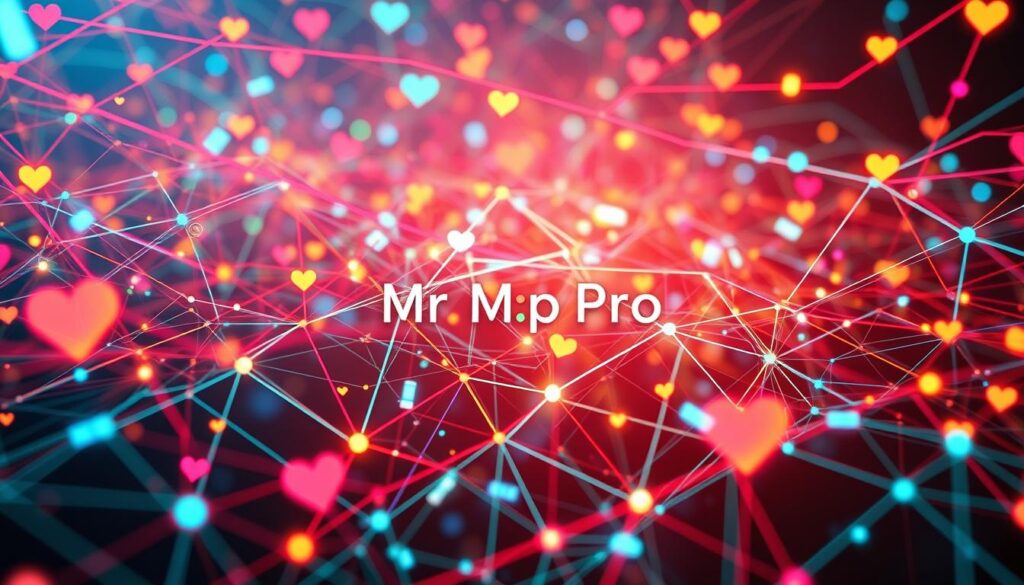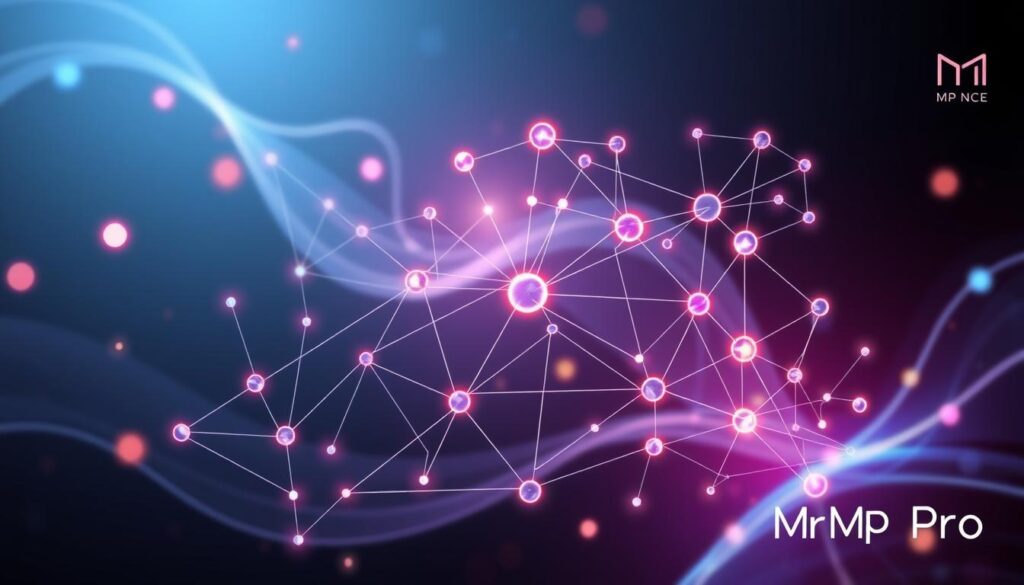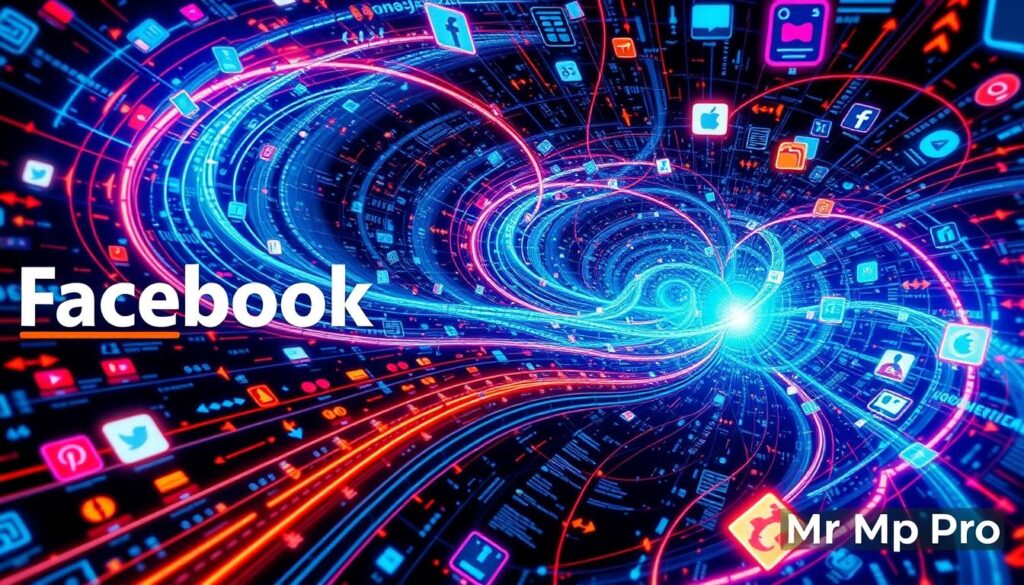
In 2018, Facebook changed its algorithm to focus on “meaningful interactions.” This change affected over 2.74 billion users. It marked a big moment in social media history, changing how we get information online.
This shift made less news appear in users’ feeds. It made the algorithm very important in what we see online.
The algorithm change hurt businesses’ organic reach. Some saw a drop of up to 50%. But, Facebook ads now offer precise targeting, helping businesses reach their audience better.
Posts that get more comments and likes are ranked higher. This means the algorithm plays a big role in your online success.
The algorithm now looks at many things, like what you like and do online. It makes feeds just for you. Knowing about the algorithm is key to navigating social media.
The Evolution of Facebook’s News Feed
Have you ever thought about how Facebook’s News Feed has changed over time? It started in 2006, changing how we use the platform. At first, posts were shown in order, making it simple to follow.
Then, EdgeRank came in 2010, changing how posts were shown. It looked at things like how much you liked a post and how long ago it was posted. This made the News Feed more personal, showing you posts that matched your interests.
Now, the News Feed uses a complex machine learning algorithm. It looks at what you like and how you interact with the site. This makes your experience more fun and relevant. To learn more about algorithms and online experiences, check out search engine optimization resources.
The News Feed’s evolution shows Facebook’s dedication to making your experience better. As the algorithm keeps improving, it will be exciting to see how it changes our interactions with the site.
Understanding the Facebook Algorithm Today
The Facebook algorithm is a complex system that ranks content based on several factors. You might notice that posts from friends and family get more attention than news. This is because the algorithm values engagement, time, and how well you know the poster.
Recent data shows that posts that get more interactions are favored. This might mean fewer people see posts that don’t get much attention. To boost your post’s visibility, learn how to optimize your content for Facebook. The algorithm also looks at how long people watch videos, aiming for 30 to 90 seconds.
Here are some important stats for Facebook content:
- 81% of businesses on Facebook are now sharing videos
- Content with higher engagement, such as likes, comments, and shares, is prioritized by the algorithm
- The algorithm evaluates how much time users spend viewing content to determine its quality
By understanding the news feed algorithm, you can make content that’s more likely to be seen. The algorithm changes often to better match what users want. So, it’s key to keep up with the latest tips for making engaging content.
The Pivotal 2018 Algorithm Update
In 2018, Facebook changed how it shows news, focusing more on personal posts. This big change hurt news sites and publishers a lot. They saw their reach drop, so they had to change how they work.
They started to focus more on engagement metrics like comments and shares. This was to get more people to see their posts.
The update also made it harder for news sites to reach their audience. To get around this, they had to make better, more engaging content. They wanted to start conversations and get people to choose their pages in their news feed settings.
The facebook updates and algorithm changes were all about making the platform better for users. They wanted to make sure people enjoyed their time on Facebook.
Some key statistics show how big the 2018 update was:
- Over 67 percent of Americans get news from social media, says Pew Research.
- Private sharing was twice as big as public sharing in 2017, GetSocial found.
- Posts with lots of comments are seen as the best way to engage users.

The 2018 update was a big deal for Facebook. It changed how Facebook shows news, making personal posts more important. News sites and publishers had to make better content to get noticed.
They had to focus on making content that started conversations and got people involved. This was to keep up with Facebook’s new rules.
| Year | Algorithm Update | Impact on News Organizations |
|---|---|---|
| 2018 | Prioritized personal posts over news content | Decline in organic reach for news organizations |
| 2018 | Introduced changes to organic reach algorithm | Publishers had to focus on creating high-quality, engaging content |
Impact on News Organizations and Publishers
The news feed algorithm update had a big impact on news groups and publishers. Many saw a drop in traffic and revenue. This change made it harder for news groups to reach their audience.
The machine learning algorithm by Facebook was key in this update. It aimed to show users more content they’d like to see.
Recent stats show a big drop in Facebook traffic to top news sites. From August 2022 to August 2023, it fell by 62%. Some big drops include:
- The Sun: 84% decline
- Business Insider: 80% decline
- The Guardian: 79% decline
This drop is due to Facebook’s ranking algorithm. It decides what content to show first in a user’s feed.

Traffic Decline Statistics
The algorithm update hit news groups and publishers hard. They saw a big drop in traffic and revenue. To stay online, they must adapt to these changes.
Understanding Facebook’s machine learning and ranking algorithms is key. This way, publishers can make their content more visible and engaging.
Rise of Personal Content in Your Feed
As you scroll through your Facebook feed, you might notice more posts from friends and family. This change is due to the facebook algorithm focusing on personal posts over news. The social media algorithm looks at many factors to guess what you’ll like, like who posts it and how people interact with it.
The personalized content algorithm sorts signals into three groups. This helps Facebook make a feed just for you. You can also pick up to 30 favorites to see more of what you like.

Some interesting facts about the facebook algorithm and user interaction include:
- 5% increase in interaction on friends’ Facebook stories after the introduction of “story bumping” in 2013
- 8% increase for content from relevant pages in 2013
- Prioritization of posts from users’ most frequent interactions in 2018, making it harder for new brands to gain audience engagement
Knowing how the social media algorithm works can help you boost your online presence. Whether you’re an individual or a business, making high-quality, personalized content is essential. It’s the key to success in the fast-changing world of social media.
| Year | Algorithm Change | Impact |
|---|---|---|
| 2013 | Introduction of “story bumping” | 5% increase in interaction on friends’ Facebook stories |
| 2016 | Prioritization of posts from friends and family | Decrease in engagement for brands and publishers |
| 2018 | Prioritization of posts from users’ most frequent interactions | Harder for new brands to gain audience engagement |
How the Algorithm Ranks Your Content
The Facebook ranking algorithm is complex. It looks at many factors to order posts in your feed. A machine learning algorithm checks thousands of signals for each post. This ensures your feed is filled with content you’ll find interesting.
The ranking process goes through several steps. It starts with inventory and signal assessment. Then, it makes predictions and calculates relevance scores. Posts with more engagement, like likes and comments, rank higher.
Several factors affect the ranking algorithm. These include:
- Engagement actions, such as likes, comments, and shares
- Viewing duration and time spent on a post
- Relationship signals, such as interactions with friends and family
- Device information, such as type, operating system, and signal strength

The algorithm aims to give you a diverse and engaging feed. It uses these factors to pick and rank posts. This way, you get a feed that’s unique and tailored to your interests.
| Factor | Description |
|---|---|
| Engagement metrics | Actions like likes, comments, and shares |
| Time decay factors | Recency of posts and time spent on a post |
| Relationship signals | Interactions with friends and family |
Misinformation and Content Quality Challenges
The facebook algorithm faces big challenges with misinformation and content quality. It’s hard to tell good content from bad with the rise of social media algorithm. About 64% of extremist group joins on Facebook come from recommendations, like “Groups You Should Join” and “Discover.”
The news feed algorithm gets criticized for focusing on engagement over truth. This has led to the spread of false information and low-quality content. It has caused serious problems, like increased ethnic tensions in Myanmar and the spread of hate and violence. Facebook has tried to fix this by using the “Click-Gap” metric to compare clicks on Facebook to the rest of the internet.

Some important stats show how Facebook’s algorithm affects content quality and misinformation:
- 71% of consumers plan to use Facebook the most over the next 12 months
- 65% of marketers plan to use Facebook the most over the next 12 months
- Facebook’s algorithm favors high-quality, original videos and limits content that tries to get more engagement
Dealing with misinformation and content quality on social media is a big challenge. It’s key to focus on quality and truth over getting more likes. We must keep watching how the facebook algorithm and social media algorithm affect content and user experience.
| Statistic | Description |
|---|---|
| 64% of extremist group joins | Due to recommendation tools |
| 71% of consumers | Plan to use Facebook the most over the next 12 months |
| 65% of marketers | Plan to use Facebook the most over the next 12 months |
Changes in User Behavior and Content Consumption
Have you noticed a change in your social media feed? The social media algorithm update has changed how we see content. Now, thanks to a machine learning algorithm, your feed shows content that matches your interests.
The news feed algorithm looks at many things, like how you’ve interacted with content before. It also checks trending topics and what your friends like. This means you’re more likely to see content that interests you, and the algorithm makes sure you see more of it.

- Increased engagement with personalized content
- More time spent on social media platforms
- A shift towards more visual content, such as videos and images
These changes come from the social media algorithm update. It wants to give you a variety of content and a well-rounded experience.
Knowing how the machine learning algorithm works can help you make your content better. For tips on optimizing your content, check out mrmp.pro/credential.
Business Impact and Marketing Adaptations
As a business owner, you’ve likely noticed changes on Facebook. The organic reach algorithm has updated, changing how your content reaches people. It’s key to understand these facebook updates and how they affect your marketing.
The algorithm changes have made it harder to reach your audience organically. Yet, this is a chance to try new marketing tactics. By using facebook updates and algorithm changes wisely, you can adjust your strategy to fit the new environment.
Organic Reach Decline
The drop in organic reach has made businesses rethink their marketing. With the organic reach algorithm favoring personal content, businesses need new ways to connect. This might mean using paid ads or making content that really speaks to your audience.
New Marketing Strategies
To thrive in this new world, businesses need fresh marketing ideas. Use facebook updates to guide your content, and tweak your targeting with algorithm changes. Focus on creating content that sparks real conversations. This can boost your visibility, drive more website visits, and increase sales.

- 80% of users interact with social content based on recommendations influenced by algorithms
- 59% of Facebook users say personalized content makes their experience better
- Content with visuals (like photos and videos) gets 120% more engagement than text-only posts
By grasping the impact of facebook updates and algorithm changes on your business, you can tailor your marketing. Aim to create engaging content that sparks real interactions. This way, you can use the organic reach algorithm to your advantage.
| Marketing Strategy | Engagement Rate | Conversion Rate |
|---|---|---|
| Paid Advertising | 40% | 20% |
| Content Marketing | 30% | 15% |
| Influencer Marketing | 25% | 10% |
The Role of Machine Learning in Feed Personalization
Ever wondered how Facebook picks what to show you in your News Feed? It’s all thanks to a machine learning algorithm. This smart system uses a ranking algorithm to show you posts that might interest you. It looks at what you’ve liked and interacted with before.
The personalized content algorithm considers many things. It looks at your likes, comments, and shares. It also checks the time and where you are. This makes your Facebook feed more fun and relevant to you.
So, how does it all work? Here are some important points:
- The algorithm uses special neural networks and online learning to guess what you like.
- It looks at over a thousand different things to decide how valuable a post is.
- First, it picks about 500 posts to rank further.
- It then looks at how you’ve interacted with posts to figure out what’s best for you.

The use of machine learning has changed how we use social media. Facebook wants to make your experience better. This means more fun for you and more success for advertisers.
Global Impact on Digital Media Landscape
The latest update to the facebook algorithm has changed the digital media world a lot. Many traditional media sites have seen a drop in visitors and money. This is because the algorithm now favors content from people you know and interact with over just likes and shares.
Now, the algorithm is key to making online content successful. About 75% of what we see on social media is picked by the algorithm. Knowing how to work with it is vital for businesses and media.
Some important stats show the algorithm’s big impact include:
- By 2023, there were about 4.5 billion active social media users worldwide.
- People spent around $150 billion on social media ads in 2023.
- More than 60 million business pages were on Facebook by the time of the analysis.
The algorithm change has also changed how we use social media. Now, people spend about 3 hours a day interacting with it. This opens up new chances for businesses to reach their audience and improve customer experiences with tailored content.
The algorithm update has had a big effect on the digital media world. It has both good and bad sides for businesses and media. As the algorithm keeps changing, it’s important to keep up and adjust strategies.
| Platform | Active Users | Advertising Investment |
|---|---|---|
| 3 billion | $150 billion | |
| 1.2 billion | $50 billion | |
| TikTok | 1 billion | $20 billion |
Current State of Social Media Algorithms
Ever wondered how your social media feeds are curated? It’s all thanks to the social media algorithm. This algorithm uses various factors to decide what you see and when. The news feed algorithm is key in shaping your online experience.
With machine learning, social media platforms can analyze your behavior. They tailor content to your interests. This makes your online experience more personalized.
Marketers are competing for social media engagement, with 80% of them doing so. Facebook, with 2.5 billion active users, shows the algorithm’s importance. It affects how we interact online, turning Facebook into a tool for maintaining relationships.
Several factors influence the social media algorithm. These include:
- Engagement metrics, such as likes, comments, and shares
- Timing, with content posted at peak hours receiving more visibility
- Content type, with video content favored due to higher engagement rates
- User behavior, with the algorithm analyzing your interactions to determine what you’re interested in
The social media algorithm is always changing. It’s vital for users to stay updated. By understanding the algorithm, you can enhance your online experience. You’ll stay connected with the content that matters to you.
| Platform | Active Users | Engagement Rate |
|---|---|---|
| 2.5 billion | 1.6% | |
| 1.2 billion | 2.2% | |
| 700 million | 2.5% |
Conclusion
The Facebook algorithm change shows how online talk is always changing. Social media keeps updating its rules to make your experience better. This change has big effects on news sites and how we see things online.
Have you seen how your social media shows more stuff you like? This is because of smart tech used by sites like Facebook and Instagram. They use your data to show you the best content.
But, this change might make us see only one side of things. It’s key to follow different sources and look for many views. This helps us understand the world better.
As social media keeps changing, it’s vital to know about these updates. By getting how these algorithms work, you can make sure your voice is heard. This way, you can stay important on these platforms.

 Facebook Algorithm Shift That Changed the Internet Forever
Facebook Algorithm Shift That Changed the Internet Forever
0 Comment